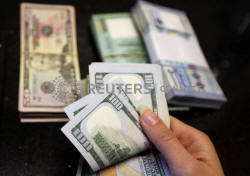Dollar heads for biggest monthly drop in a decade as
virus fuels U.S. economy fears
 Send a link to a friend
Send a link to a friend
 [July 31, 2020] By
Tommy Wilkes [July 31, 2020] By
Tommy Wilkes
LONDON (Reuters) - The dollar extended its
dramatic fall on Friday, putting it on course for its biggest monthly
drop in a decade as investors fretted that a rebound in the U.S. economy
would be derailed by the struggle to stem the coronavirus epidemic.
Weakness in the U.S. currency propelled the euro higher, with the single
currency touching $1.19, its strongest since May 2018, and enjoying its
biggest monthly gain since September 2010.
Confidence in the dollar was undermined further after U.S. President
Donald Trump on Thursday raised the possibility of delaying the November
presidential election.
That came on the same day advance gross domestic product (GDP) data
showed contraction of an annualised 32.9% in the second quarter, the
quickest pace since the Great Depression.
The dollar index slid as low as 92.546 <=USD> in early trading on
Friday, a level last seen in May 2018, before recovering to trade flat
at 92.847.

It has fallen nearly 5% in July, with most of the drop coming in the
last 10 days as new cases of coronavirus surged across several U.S.
states and some recent data pointed to an economic recovery losing
steam.
Graphic: U.S. dollar index -
https://fingfx.thomsonreuters.com/
gfx/mkt/nmovalywbpa/dollar%20index.PNG
GLOBAL CONCERNS
Unicredit analysts said they "continue to expect the USD weakness to
persist in August, a month in which abrupt moves in intraday activity
tend to be more likely due to lighter market conditions."
But they said that given global economic growth concerns and worries
about further COVID-19 developments, and the depreciation the U.S.
dollar has already suffered in recent weeks, downward pressure would be
"less intense" over the next month.
The euro surged to as high as $1.1908 before settling at $1.1854 <EUR=EBS>,
up 0.1% on the day.
[to top of second column] |

A woman counts U.S. dollar banknotes as Lebanese pounds are pictured
in the background at a currency exchange shop in Beirut, Lebanon
April 3, 2020. REUTERS/Mohamed Azakir

The currency was little moved by data showing the euro zone economy recorded its
deepest contraction on record in the second quarter while the bloc's inflation
unexpectedly ticked up in July.
The euro traded below $1.10 as recently as May, but after European Union leaders
agreed this month to a 750 billion euro economic recovery fund - while also
taking on debt jointly in a major boost to regional cooperation - many investors
have warmed to the currency again.
On a trade-weighted basis, the euro is at its highest since 2014 <EUREER=ECBF>.
"Disinflationary pressure from the unprecedented hit to demand alongside the
strengthening euro will keep pressure on the ECB to deliver further policy
stimulus," MUFG analyst Lee Hardman said.
The dollar's drop this month has created space for a rebound in currencies hit
hard in March, when investors rushed for the safety of the greenback as panic
over the coronavirus gripped markets.
Against the yen, the dollar hit a 4-1/2 month low of 104.195 yen and last stood
at 104.64 <JPY=EBS>, having lost 3.3% this month.
The British pound surged to $1.3143 <GBP=D3>, a 4-1/2 month high. It was
slightly stronger versus the euro at 90.33 pence <EURGBP=D3>.
The Swiss franc extended its rally against the dollar, with the U.S. currency at
its weakest since early 2015 and last down another 0.1% at 0.9077 francs <CHF=EBS>.
(Additional reporting by Hideyuki Sano in Tokyo Editing by Jan Harvey and David
Holmes)
[© 2020 Thomson Reuters. All rights
reserved.] Copyright 2020 Reuters. All rights reserved. This material may not be published,
broadcast, rewritten or redistributed.
Thompson Reuters is solely responsible for this content. |